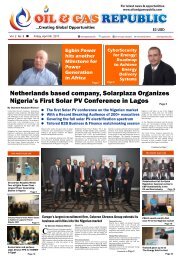OGRepublic August Edition
This edition is focused on Shell Nigeria Exploration and Production Company 'Digital Twin' for its Bonga FPSO.
This edition is focused on Shell Nigeria Exploration and Production Company 'Digital Twin' for its Bonga FPSO.
You also want an ePaper? Increase the reach of your titles
YUMPU automatically turns print PDFs into web optimized ePapers that Google loves.
SNEPCO’s ‘DIGITAL TWIN’: A Structural
Model For FPSO Digitalisation, Local Cotent
Opportunities in Nigeria’s Deepwater Operation
A
digital twin is a virtual representation of a physical object, assets,
process or service. The digital twin technology can be used to replicate
processes to collect data to predict how they will perform. This concept
was originated from NASA in an attempt to improve the physical model
simulation of spacecraft in 2010.
According to Wikipedia analysis, Digital twins were anticipated by David
Gelernter's 1991 book known as 'Mirror Worlds'. It is widely acknowledged in
both industry and academic publications that Michael Grieves of the Florida
Institute of Technology first applied the digital twin concept in manufacturing.
The concept and model of the digital twin were publicly introduced in 2002 by
Grieves, then of the University of Michigan, at a Society of Manufacturing
Engineers conference in Troy, Michigan. Grieves proposed the digital twin as
the conceptual model underlying product lifecycle management (PLM).
By Ndubuisi Micheal Obineme
Facts about SNEPCO’s Bonga FPSO
Ø Bonga is Nigeria’s first deep-water project.
Ø It created the first generation of Nigerian oil
and gas engineers
Ø It increased Nigeria’s oil capacity by 10%.
Going forward, the offshore energy industry has embraced the digital twin
technology to enhance efficiency and safety, reduce maintenance and
operating costs, and support asset life extension. Industry experts have said
that the 'Digital Twin' allows operators to obtain greater insights to improve
inspection, maintenance, and repair (IMR).
This article focuses on the deployment of digital twin technology at the Shell
Nigeria Exploration and Production Company’s (SNEPCO) Bonga floating,
production, storage, offloading (FPSO) vessel which is leading the way to
digitalising Nigeria's deepwater operation; highlighting the local content
opportunities this could provide to indigenous service companies who are
offering engineering and technological solutions in the Nigerian oil and gas
industry.
The Bonga project, which began producing oil and gas in 2005, was Nigeria’s
first deep-water development project. The Bonga project helped create the
first generation of Nigerian oil and gas engineers with deep water experience
and stimulated the growth of major industries.
The project increased Nigeria’s oil capacity by 10% when output began in 2005.
Oil from the Bonga North West sub-sea facilities is transported by a new
undersea pipeline to the existing Bonga floating production, storage and
offloading (FPSO) export facility.
49
Ø Bonga FPSO can produce 225,000 barrels of
oil and 150 million standard cubic feet of gas
per day.
Ø During the COVID-19 pandemic, Akselos
deployed a structural digital twin on the Bonga
FPSO to enhance production.
Ø SNEPCO’s digital twin is leading the way to
digitalising Nigeria’s deepwater operation.
Ø Akselos digital twin for SNEPCO has been
selected as one of the most promising World
Economic Forum Technology Pioneers 2020.
Ø SNEPCO is keen to support indigenous
companies to develop a ‘Made in Nigeria
Digital Twin’
OIL AND GAS REPUBLIC I SPECIAL EDITION















